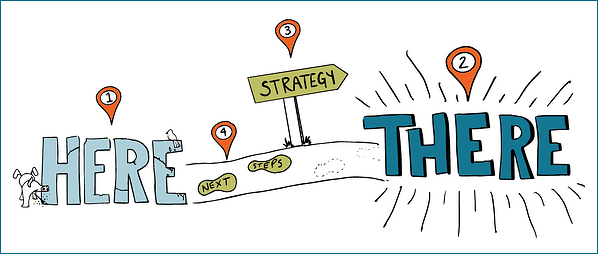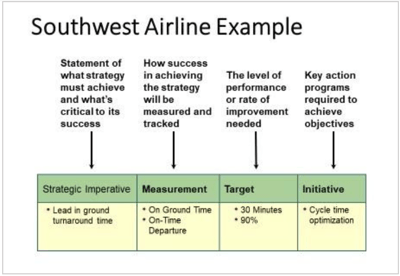“I don’t know where to start.”
With so many thoughts and ideas swirling around, it is easy to feel overwhelmed when embarking on a strategy development and planning process. Many a strategy coaching client will start the engagement with a long PowerPoint full of ideas and analyses — their head swimming with more questions than answers. It can be hard to get your footing when creating the future.
At its most fundamental level, a strategic plan outlines:
- Where are you NOW? This is your current state (internal and external landscape).
- Where do you want to BE? This is your desired future state.
- How will you GET there? This is the pathway from here to there.
This graphic remains my favorite reference to strategy development, both for its playfulness and its simplicity.
 Each can be a point of entry to your strategy development and planning. Perhaps not in the linear order you might expect. When creating the future, you will need to look through each distinct lens and iterate between them to decide how to position your business and allocate limited resources for maximum strategic impact.
Each can be a point of entry to your strategy development and planning. Perhaps not in the linear order you might expect. When creating the future, you will need to look through each distinct lens and iterate between them to decide how to position your business and allocate limited resources for maximum strategic impact.
[Note: This article is oriented toward strategic planning in established businesses and assumes foundational elements like mission, vision, and values already exist. They are the broader container to this next‑level strategy work.]
HERE: Where are you now?
An easy way for strategic leaders to begin is by looking at what IS — internally and externally. This determines your current strategic position and assesses how you may need to change.
Many strategy frameworks have been created to derive strategic insight into your “Here,” such as the age‑old SWOT:
- Strengths (internal)
- Weaknesses (internal)
- Opportunities (external)
- Threats (external)
SWOT has staying power for a reason. It is a quick way to assess your current state.
There are plenty more frameworks that you can explore, AND it is easy to invest a lot of time here without sufficient impact.
PRO TIP: When I led corporate strategy, we used a simple litmus test to guide our analytic work. We considered the “so what” of analysis before we started it. If we couldn’t envision a potential insight or strategic direction‑setting decision that would be informed by the analysis, we let it go.
Watch out for the comfort and false sense of “knowing” that analytics can provide. We can’t analyze, or know, our way into the future. Don’t let analyses seduce you away from the hard work of creating the future.
Plan/Pathway: How will you get from here to there?
The strategic plan is the most tangible part of strategy development. Just like an operating plan, it includes goals, objectives, and key activities to deliver the desired results.
Outlining your key initiatives can be a practical place to start your strategic plan as you likely already have a sense for what needs to be different from today. What new capabilities need to be built by when (think people, skills, process, system, culture)?
For example:
- A sales channel to a new customer type
- A different way of selling (i.e. product to solution)
- Systems and automation to support scaling and financial viability
- A product development process to accelerate new product introduction and increase the likelihood of market success
Where do you need to invest resources to position the business for the future?
Core Elements
Following are the core elements of your strategic plan. Each brings greater and greater focus and specificity of action that will move you toward your envisioned future state.
1. Strategic Imperatives
These are the long-term focus areas of change that move you toward your desired future state. They should sustain over the planning horizon and focus the organization on the most critical change state for the business. I recommend no more than three to five strategic imperatives. Areas of change may include who you serve (core customers/market geographies), how you serve them (sources of value creation), and the enabling capabilities.
While different labels may be used — strategic imperatives, objectives, priorities — whatever you call them, they are overarching statements of what you must achieve. What must be different in three to five years for you to have positioned the business for the future?
For example:
-
Transform cancer standard of care
-
Be our customers’ scientific partner of choice
-
Establish global presence
-
Scale the organization
2. Strategic Objectives or Measures
Strategic measures tell us how we will know that we are advancing our goals. They provide a tangible way to measure progress toward a goal that should be tracked and monitored on a regular basis.

Strategic measures should sustain over the planning horizon, with annual targets set for each year that put the organization on the right trajectory to achieving its desired future state.
3. Strategic Initiatives
This is where the plan becomes actionable as you invest limited resources to advance your strategic objectives. Strategic initiatives are projects that include a scope, budget, start/end date, and a responsible party/function. They are the specific actions that close the gap from “here” to “there” and allow you to hit your targets.
What makes these different from an operational initiative? Operations preserve value. Strategy increases value. Operational initiatives tend to be continuous improvement of existing processes. At this point, the Southwest example above is an existing process. But when they were creating their differentiated strategy, this was a new organizational capability. Strategic initiatives focus on creating new capability and value to … you guessed it, “position the organization for the future.”
Organizations often have a long list of initiatives — much longer than the resources available to fund the plan. Prioritization will be a combination of relative priority across initiatives and relative priority over the planning horizon. This HBR article outlines a helpful approach to determining relative priorities.
4. Roadmap
The strategic roadmap guides prioritization, focus, and resource allocation over the planning horizon. In this step we envision what needs to happen (strategic initiatives) in the next 1-2 years, 2-3 years, 3+ years … to realize your “there”?
5. Long-Range Financial Plan
The larger your organization, the more likely a long-range financial planning process exists to create a three- to five-year income statement. As the P&L is the common language of business (and investors), it becomes a way to speak to your business future.
Ideally, the financial plan is rooted in your strategic thinking and represents the quantification of your strategic initiatives. It is a way to envision/confirm your long-term growth drivers and how the overall investment profile of the organization may change over time (i.e., expense ratios like R&D or SG&A as a percent of sales).
The key is to use the financial plan as a strategic thinking exercise versus a budgeting exercise. Despite the concrete nature of numbers, we are still creating an unknowable future.
PRO TIP: Link your strategic imperatives to a revenue growth walk from “here” to “there.” So if you will increase revenue by $100M over the planning horizon, how much of that comes from new products/services, new customers, geographic expansion?
THERE: Where do you want to be?
You might be wondering why we didn’t focus on “There” before the strategic plan. No doubt it sets the strategic direction, and all other decisions should flow from it. AND “There” can be the hardest of the three core elements because it forces us to make bets on a future we can only guess at.
This is where we flex our strategic thinking. Where we anticipate, challenge the status quo, rethink opportunities, and create new realities.
In creating your strategic plan and key initiatives, you inherently are defining a change state. A list of goals to achieve — things to make different over the planning horizon. It is easy for the plan to be just that — a list of goals and initiatives. A number of “go do’s,” but to what end? What do they all add up to?
This is the art of strategy and what makes your plan truly strategic.
A strategist’s job is to create, differentiate, and … surprise! … position for the future. To build an organization in a way that creates distinct value for customers AND is difficult for competitors to replicate.
What is your vision for that future? And how will you describe it in a way that drives aligned action throughout the organization?
Most organizations have a high-level vision statement that describes the impact the company wants to make on a community or on the world as a result of their services. Like “a world without cancer.” I refer to this as “Big V” — Vision. It should be inspirational, foundational, and built to last.
PRO TIP: Visions often endure for decades, which makes them too broad to guide nearer-term strategic decision-making. For those, I think about “little v” vision, which describes that future position in the next three to five years.
In a previous article, I shared different approaches to defining your “there” (“little v”) with an emphasis on where you want to go instead of what you want to achieve. This clarity of strategic direction provides the strategic basis to decide where to focus resources for greatest impact.
Picking Your Point of Entry
As you embark on your next strategy development and planning process, remember the purpose of your strategic plan is to align short-term actions with long-term direction.
You will need to create a point of view about:
- Your HERE. Your current state (internal and external landscape).
- Your THERE. Where do you want to BE? What is your desired future state?
- Your PLAN/PATHWAY. How will you GET from here to there?
Perhaps not in that order. Before you jump into the deep end of the “strategy pool,” play around with the core elements of your strategic plan.
The plan is the most actionable. It also leverages your business insight and acumen. Many leaders can articulate what needs to change, even when it may be harder for them to articulate the why — the strategic logic behind their recommendations. And many a plan has been created without this strategic clarity that still created greater organizational alignment.
From there you can experiment with ways to make your plan more strategic, distinct, and transformational. What new or distinct insight from your “here” might inform your “there”?
The art of strategy will emerge as you go.



